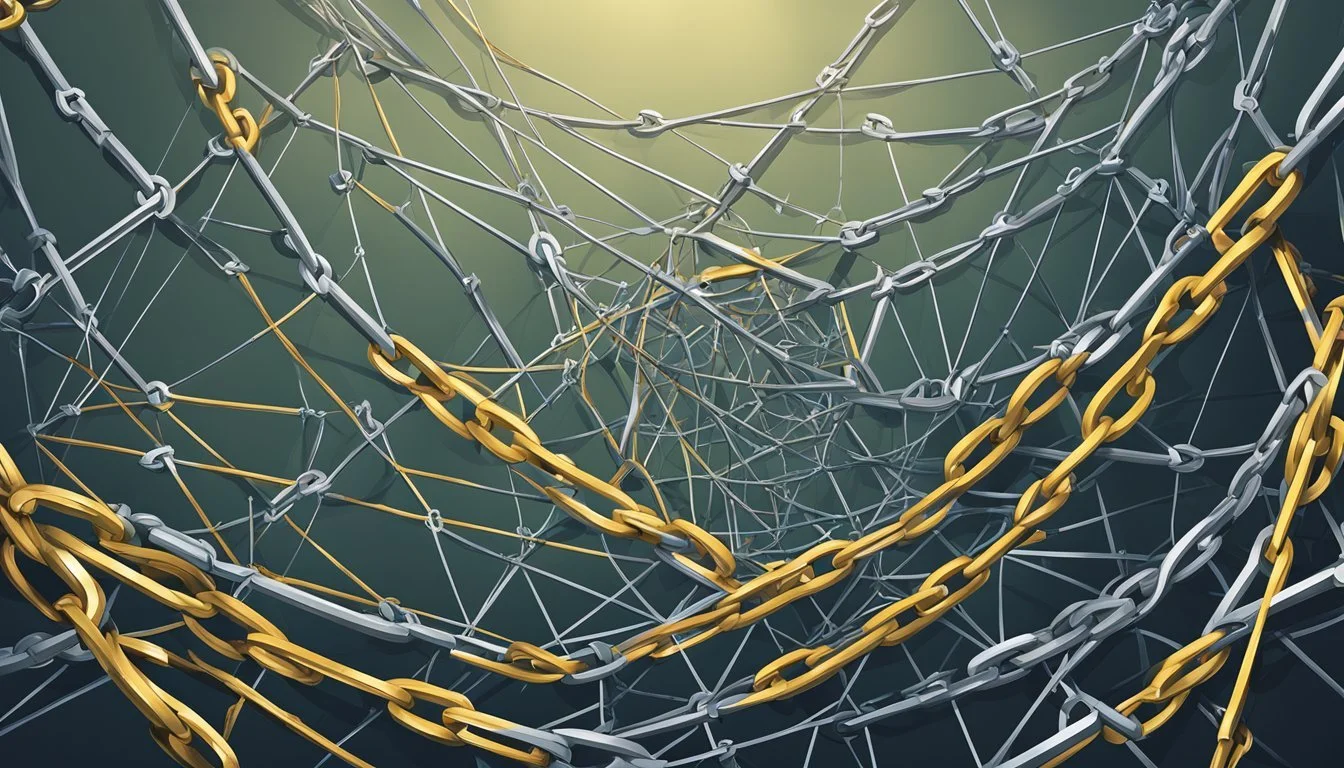Shocking Truths: Toxic Relationship Statistics That Impact Your Well-Being
Toxic relationships can have a profound impact on mental health and overall well-being. Research indicates that a significant portion of Americans experience stress and negative effects from unhealthy interpersonal dynamics. Studies show that 75% of employees report their boss as the most stressful part of their workday, highlighting the prevalence of toxic relationships in professional settings.
The consequences of toxic relationships extend beyond the workplace. Mental health statistics from 2024 reveal a strong connection between relationship quality and psychological well-being. While positive relationships can enhance happiness and reduce stress, toxic interactions contribute to mental health struggles. This underscores the importance of fostering healthy connections in all aspects of life.
Recognizing the signs of a toxic relationship is crucial for maintaining mental health. These may include constant criticism, lack of support, emotional manipulation, or feelings of anxiety and depression when interacting with the other person. By understanding these indicators, individuals can take steps to address unhealthy dynamics or seek support to improve their relationships and protect their mental well-being.
Defining Toxic Relationships
Toxic relationships involve harmful patterns of behavior that negatively impact one's emotional and psychological well-being. These relationships are characterized by various forms of abuse, manipulation, and control.
Characteristics of Toxic Relationships
Toxic relationships often involve emotional abuse, where one partner consistently belittles, criticizes, or humiliates the other. Verbal abuse, including name-calling and put-downs, is a common feature. Manipulation tactics like gaslighting may be employed to make the victim doubt their own perceptions.
Control is another key aspect. A toxic partner may attempt to isolate their significant other from friends and family. They might monitor their partner's activities excessively or make unreasonable demands.
Constant conflict and lack of support are hallmarks of toxic dynamics. Arguments may escalate quickly and remain unresolved. One partner may consistently prioritize their own needs over the other's.
Differences Between Healthy and Unhealthy Relationships
Healthy relationships are built on mutual respect, trust, and open communication. Partners support each other's growth and independence. Conflicts are addressed calmly and resolved through compromise.
In contrast, unhealthy relationships lack these positive attributes. Trust is often broken through lying or infidelity. Communication is poor, with partners avoiding difficult conversations or resorting to yelling and blaming.
Boundaries are respected in healthy relationships, while toxic ones often involve boundary violations. Healthy couples encourage each other's individuality, whereas toxic partners may try to change or control the other person.
Equality is a key difference. Healthy relationships involve shared decision-making and mutual effort. Toxic relationships are often imbalanced, with one partner holding more power or making all the decisions.
Prevalence of Toxic Relationships
Toxic relationships affect a significant portion of the population across age groups and genders. Research reveals concerning rates of psychological aggression, intimate partner violence, and teen dating abuse.
Statistical Overview by Age and Gender
Studies show that toxic relationships impact both adults and teens. According to the American Psychological Association, 75% of employees report their boss as the most stressful part of their workday, indicating widespread toxicity in professional relationships.
In intimate partnerships, rates vary by age. The CDC's Youth Risk Behavior Survey found that about 1 in 12 teens experience physical or sexual dating violence. Some studies suggest even higher rates when including psychological abuse.
Gender differences exist in abuse patterns. Research indicates that both men and women can perpetrate and experience intimate partner violence, though prevalence rates may differ.
Impact of Societal Expectations and Gender Roles
Societal norms and gender expectations influence toxic relationship dynamics. Traditional gender roles can contribute to power imbalances and unhealthy behaviors in partnerships.
Women may face increased pressure to maintain relationships despite toxicity. Men might struggle to recognize or report abuse due to masculine stereotypes.
These societal factors can make it challenging for individuals to identify and address toxic patterns in their relationships. Awareness of how gender roles shape expectations is crucial for understanding and preventing relationship toxicity.
Consequences of Toxic Relationships
Toxic relationships can inflict severe damage on an individual's wellbeing. The negative impacts often extend far beyond the relationship itself, affecting multiple aspects of a person's life.
Physical and Psychological Health Effects
Chronic stress from toxic relationships can lead to numerous health problems. Individuals may experience headaches, digestive issues, and weakened immune systems. Sleep disturbances are common, potentially resulting in insomnia or fatigue.
Psychological effects can be equally devastating. Depression and anxiety frequently occur in those subjected to toxic dynamics. Post-traumatic stress disorder (PTSD) may develop, especially in cases involving abuse or severe manipulation.
Eating disorders and substance abuse often emerge as coping mechanisms. These unhealthy behaviors can further deteriorate physical health and exacerbate mental health issues.
Emotional and Social Implications
Toxic relationships erode self-esteem and confidence. Constant criticism or gaslighting can lead individuals to doubt their own perceptions and worth. This diminished sense of self may persist long after the relationship ends.
Social isolation is a common consequence. Toxic partners may actively discourage outside relationships, leading to a shrinking support network. Even without direct interference, shame or fear can cause individuals to withdraw from friends and family.
Trust issues often develop, making it difficult to form healthy connections in the future. This can impact personal and professional relationships alike, potentially limiting career opportunities and social fulfillment.
Patterns and Risk Factors
Toxic relationships exhibit recurring harmful behaviors and specific risk factors that contribute to their development. Understanding these patterns and risk factors is crucial for identifying and addressing unhealthy dynamics in relationships.
Identifying Patterns of Behavior in Toxic Relationships
Toxic relationships often display consistent patterns of negative behavior. These may include frequent criticism, manipulation, and emotional turmoil. Partners in such relationships might experience a cycle of tension, conflict, and reconciliation.
Control and dominance are common themes. One partner may dictate choices, finances, or social interactions of the other. This behavior can escalate over time, becoming more pronounced and damaging.
Constant criticism and blame are hallmarks of toxic dynamics. One partner may consistently belittle or undermine the other, eroding their self-esteem and confidence.
Risk Factors Contributing to Toxic Dynamics
Several factors increase the likelihood of developing or maintaining toxic relationships. Age can play a role, with younger individuals sometimes lacking the experience to recognize unhealthy patterns.
Past trauma or exposure to dysfunctional relationships can normalize toxic behaviors. People who grew up in households with unhealthy dynamics may unknowingly replicate these patterns in their own relationships.
Low self-esteem and poor emotional well-being can make individuals more susceptible to toxic relationships. They may accept mistreatment or struggle to set healthy boundaries.
Mental health issues, substance abuse, and unresolved personal problems can contribute to toxic behaviors in relationships. These factors may exacerbate existing tensions and create new conflicts.
Impact of Digital Communication
Digital technology has transformed how romantic partners interact and relate to each other. Social media and messaging apps enable constant connection but can also introduce new challenges.
Role of Social Media and Technology in Relationships
Social media plays a significant role in modern relationships. 45% of internet users ages 18-29 in serious relationships report the internet has impacted their partnership. Couples use platforms like Facebook and Instagram to stay connected throughout the day.
Dating apps have become a common way to meet potential partners. However, the abundance of options can lead to "choice overload" and make commitment more difficult for some.
Digital communication allows for instant connection but may reduce quality face-to-face time. Some couples struggle to be fully present with each other when devices are always within reach.
Cyberbullying and Online Harassment in Romantic Contexts
Online harassment affects many romantic relationships. A partner may use social media to monitor, control, or embarrass their significant other.
Common forms of digital abuse include: • Demanding passwords • Excessive texting/calling • Posting intimate photos without consent • Using location tracking apps
Women are more likely than men to experience severe forms of online harassment from a partner or ex-partner. 40% of women report that relationship posts on social media negatively impact their dating lives, compared to 28% of men.
Cyberbullying between partners can cause significant emotional distress and damage trust. Setting clear boundaries around digital communication is important for maintaining healthy relationships.
Strategies for Prevention and Intervention
Effective approaches focus on building healthy relationships and providing support systems. These strategies aim to break cycles of toxicity and foster positive connections.
Building Healthy Communication and Boundaries
Clear communication and strong boundaries are essential for preventing toxic relationships. Couples can learn to express needs and concerns respectfully. Active listening skills help partners understand each other's perspectives. Setting and respecting personal boundaries reduces conflict and builds trust.
Anger management techniques allow individuals to process emotions constructively. Conflict resolution skills enable couples to address issues without escalating tensions. Learning to recognize early warning signs of toxic behavior is crucial.
Relationship education programs teach these vital skills. They cover topics like effective communication, conflict management, and emotional intelligence. Such programs can be offered in schools, community centers, or through online platforms.
The Role of Counseling and Support Systems
Professional counseling provides a safe space to address relationship issues. Therapists can help identify unhealthy patterns and develop coping strategies. Couples therapy focuses on improving communication and resolving conflicts. Individual therapy supports personal growth and healing from past traumas.
Support groups offer peer connections and shared experiences. Domestic violence hotlines provide immediate assistance and resources. Family and friends play a crucial role in offering emotional support and practical help.
Community resources like women's shelters offer safety and services for those leaving abusive situations. Legal aid can assist with protective orders and custody issues. Mental health services address underlying issues that contribute to toxic behaviors.
Legal and Social Resources
Legal protections and support networks play a crucial role in addressing toxic relationships. Victims have access to various legal options and community resources to help them safely leave abusive situations and heal.
Legal Recourse for Victims of Dating and Domestic Abuse
Restraining orders provide legal protection by prohibiting abusers from contacting or coming near victims. Violating these orders can result in arrest. Victims can also press criminal charges for assault, stalking, or other offenses.
Family courts can grant protective orders and determine custody arrangements to safeguard children. Some areas have specialized domestic violence courts to handle these sensitive cases.
Free legal aid is often available to help victims navigate the justice system. Lawyers can assist with filing for divorce, division of assets, and obtaining compensation for damages.
Availability of Support Networks and Resources
Crisis hotlines offer 24/7 support, safety planning, and referrals. Many communities have domestic violence shelters providing emergency housing, counseling, and other services.
Support groups allow survivors to connect with others who understand their experiences. These groups can reduce isolation and provide emotional support during the healing process.
Victim advocates guide survivors through legal proceedings and help access community resources. They often work within police departments, courts, and social service agencies.
Mental health professionals specializing in trauma can provide individual and group therapy. Some offer sliding scale fees to make treatment more affordable.
Moving Forward After a Toxic Relationship
Leaving a toxic relationship marks the beginning of a healing journey. Rebuilding one's life requires focused effort on recovery and developing resilience.
Healing and Recovery Process
Acknowledging the impact of the toxic relationship is a crucial first step. Many experience feelings of guilt, shame, and self-doubt. Seeking professional help, such as therapy or counseling, can provide valuable support and guidance.
Processing emotions takes time. Journaling helps express feelings and track progress. Practicing self-care through exercise, proper nutrition, and adequate sleep aids physical and emotional recovery.
Establishing boundaries is essential. This includes limiting contact with the toxic ex-partner and surrounding oneself with positive influences. Building a support network of trusted friends and family creates a safe environment for healing.
Strategies for Building Self-Esteem and Resilience
Rebuilding self-esteem starts with challenging negative self-talk. Positive affirmations and self-compassion exercises help counter harmful beliefs ingrained during the toxic relationship.
Setting and achieving small goals boosts confidence. This could involve learning a new skill, pursuing a hobby, or completing a personal project. Celebrating these accomplishments reinforces self-worth.
Practicing mindfulness and meditation enhances emotional regulation. These techniques help manage stress and anxiety, common aftereffects of toxic relationships.
Engaging in activities that bring joy and fulfillment nurtures a positive self-image. Volunteering or joining community groups can provide a sense of purpose and connection.
Gradually exploring new, healthy relationships helps rebuild trust. This includes platonic friendships and potential romantic partners. Taking things slow allows time to apply lessons learned from past experiences.







